
How to Use NEO-6M(GPS MODULE): Examples, Pinouts, and Specs
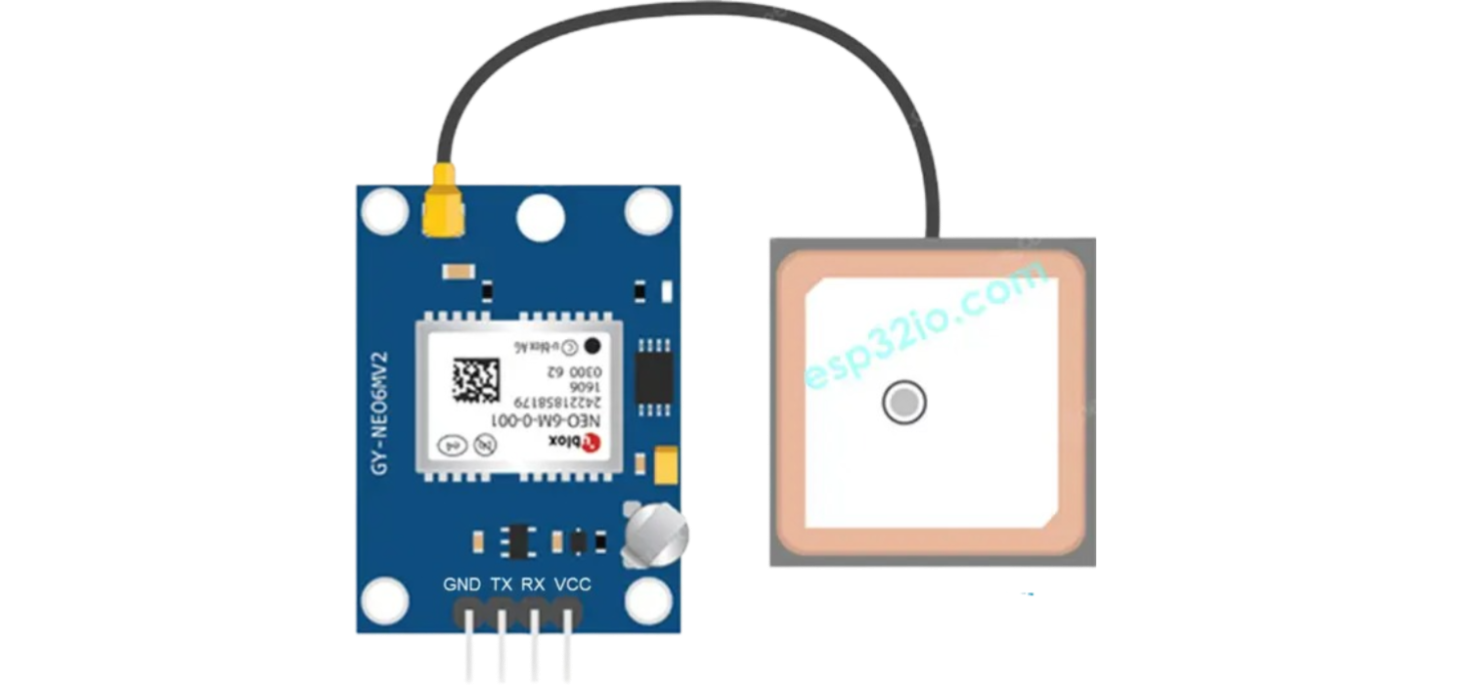
 Design with NEO-6M(GPS MODULE) in Cirkit Designer
Design with NEO-6M(GPS MODULE) in Cirkit DesignerIntroduction
The NEO-6M GPS module is a compact, high-performance satellite positioning system receiver that provides a simple solution for integrating GPS functionality into various electronic projects. It is based on the u-blox NEO-6 series receiver chipset which is capable of tracking up to 50 satellites at a time and has a high level of sensitivity for improved accuracy. Common applications of the NEO-6M GPS module include drones, vehicle tracking systems, personal navigation devices, and time synchronization.
Explore Projects Built with NEO-6M(GPS MODULE)
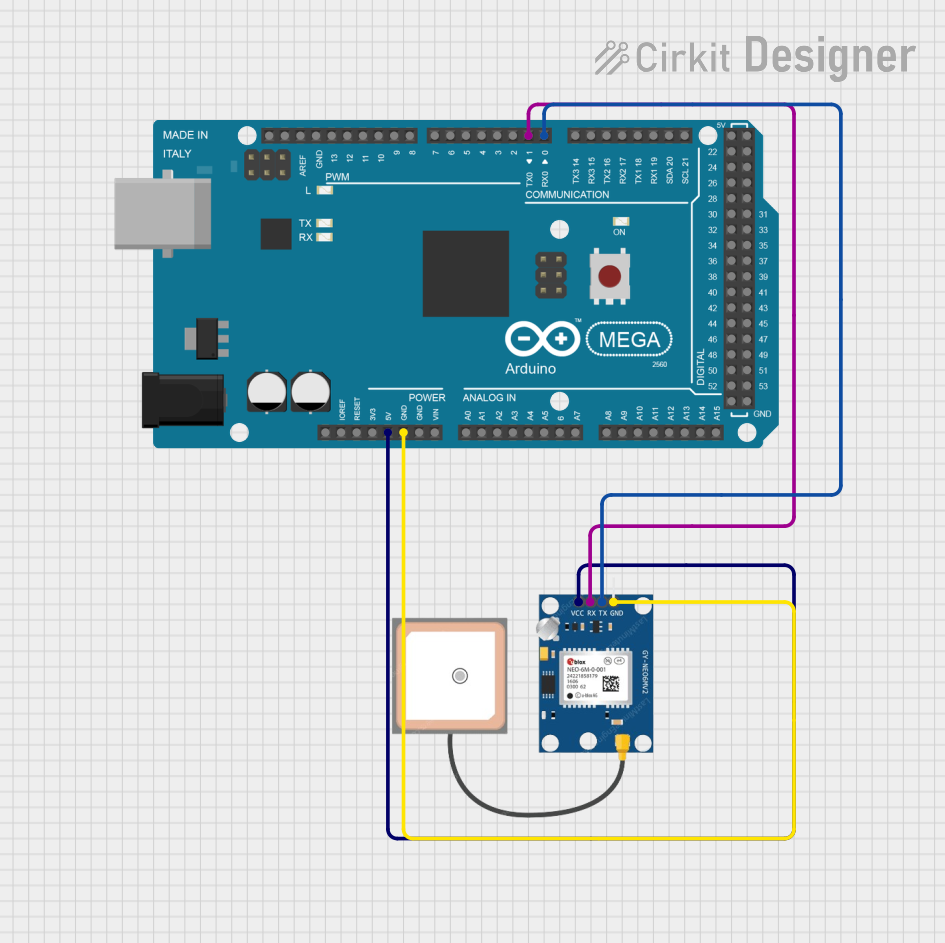
 Open Project in Cirkit Designer
Open Project in Cirkit Designer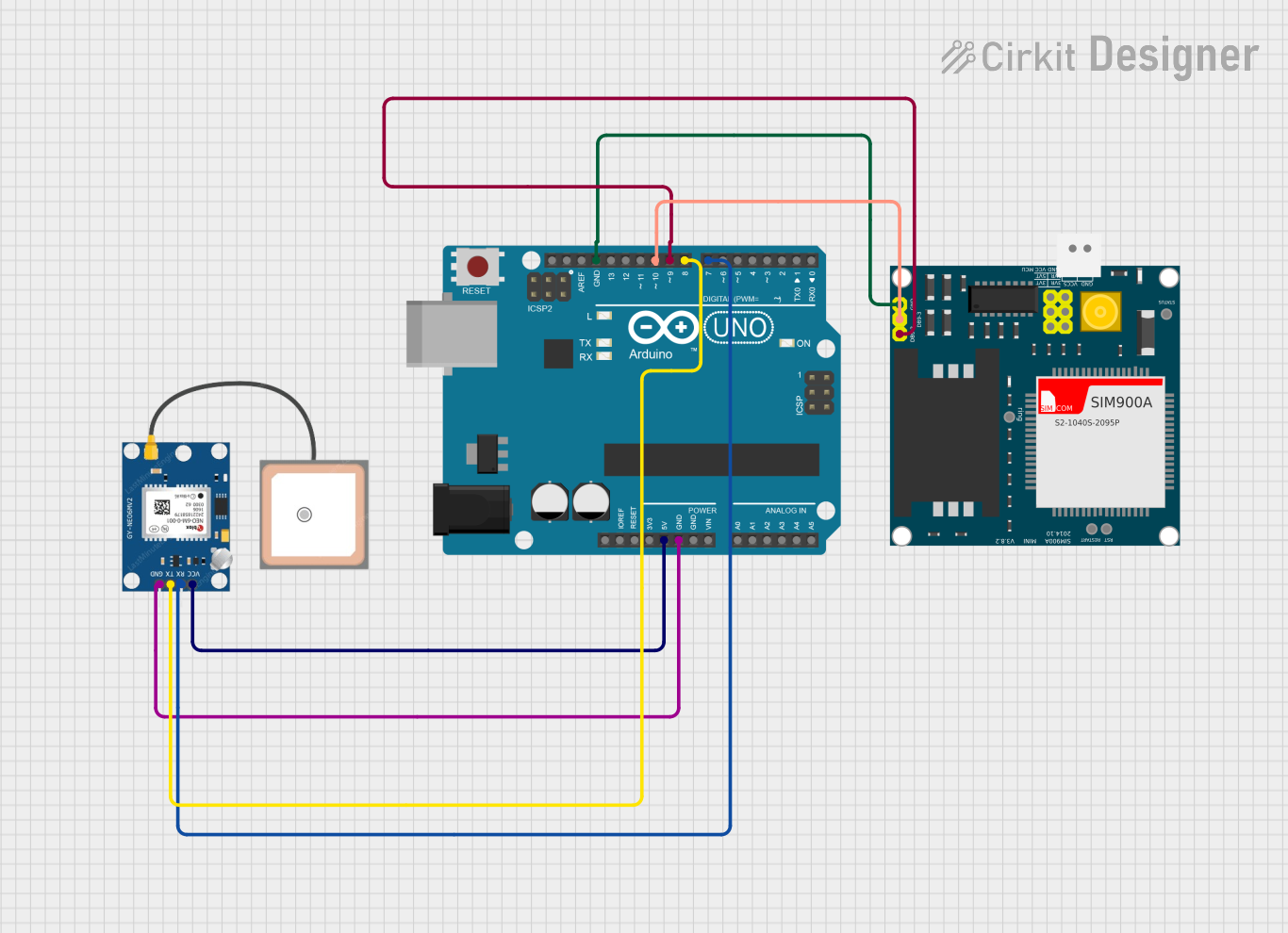
 Open Project in Cirkit Designer
Open Project in Cirkit Designer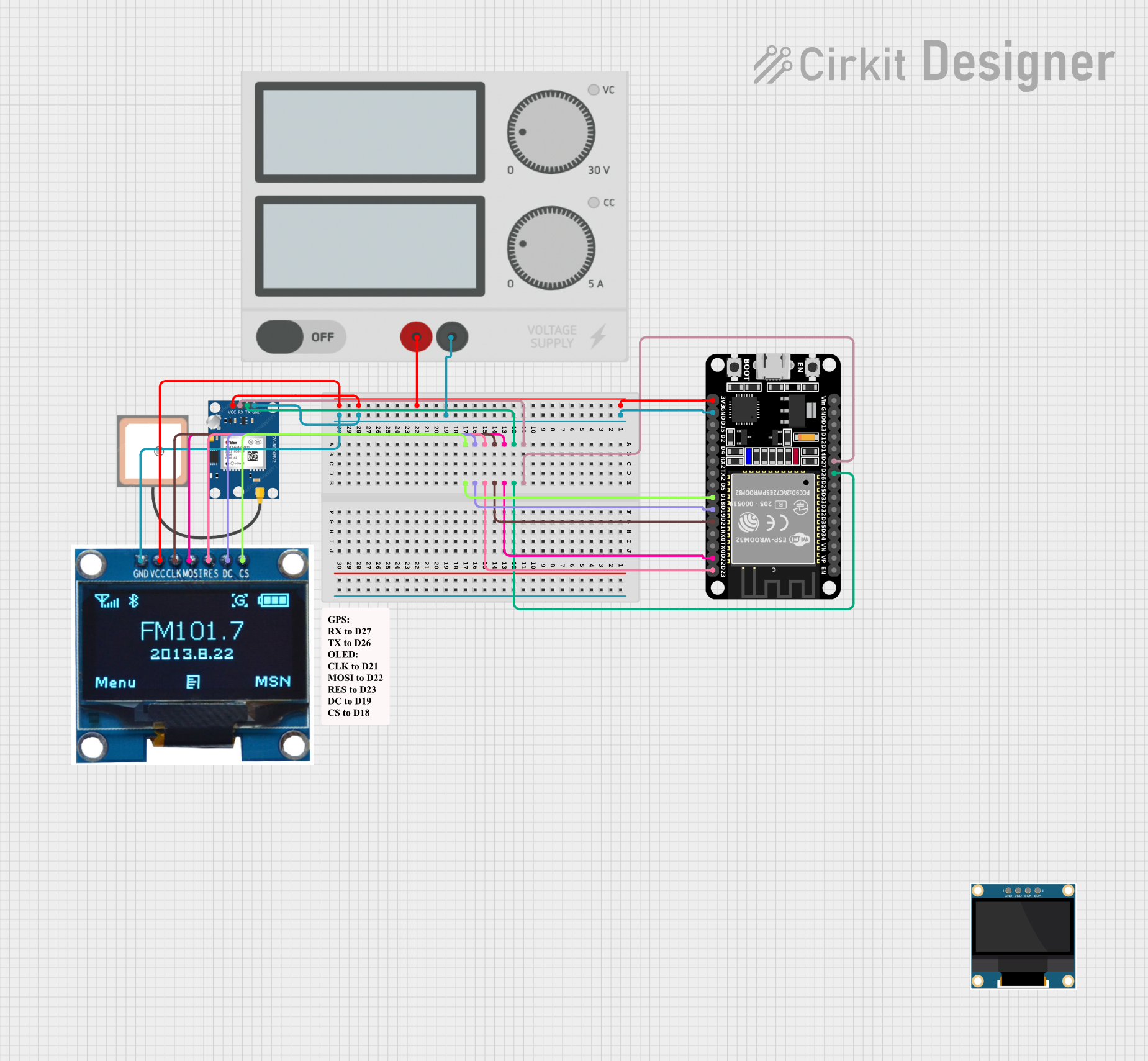
 Open Project in Cirkit Designer
Open Project in Cirkit Designer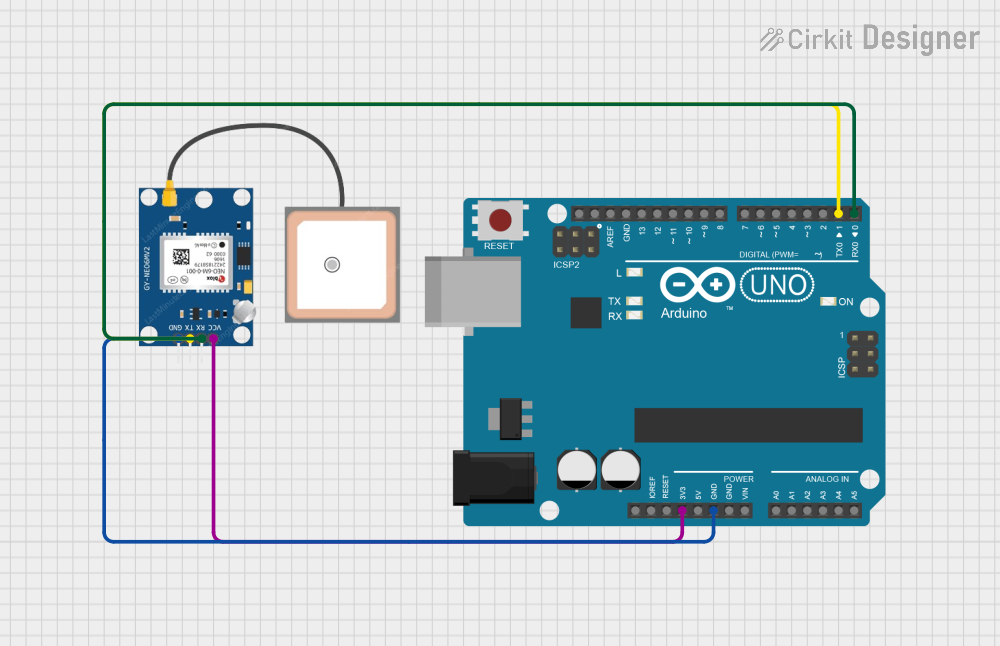
 Open Project in Cirkit Designer
Open Project in Cirkit DesignerExplore Projects Built with NEO-6M(GPS MODULE)

 Open Project in Cirkit Designer
Open Project in Cirkit Designer
 Open Project in Cirkit Designer
Open Project in Cirkit Designer
 Open Project in Cirkit Designer
Open Project in Cirkit Designer
 Open Project in Cirkit Designer
Open Project in Cirkit DesignerTechnical Specifications
Key Technical Details
- Receiver Type: 50 Channels, GPS L1 frequency, C/A Code
- Position Accuracy: 2.5 meters Autonomous
- Update Rate: Up to 5 Hz
- Acquisition Times: Cold starts: 27s, Aided starts: 3s, Reacquisition: 1s
- Sensitivity Tracking & Navigation: –161 dBm
- Operating Temperature: –40 °C to 85 °C
- Supply Voltage: 3.0V to 5.5V
- Power Consumption: 50mA at 5V
Pin Configuration and Descriptions
| Pin Number | Pin Name | Description |
|---|---|---|
| 1 | VCC | Power supply (3.0V to 5.5V) |
| 2 | GND | Ground |
| 3 | TX | Transmit data out (TTL level) |
| 4 | RX | Receive data in (TTL level) |
| 5 | PPS | Pulse per second output |
Usage Instructions
Integration into a Circuit
- Power Connection: Connect the VCC pin to a 3.0V to 5.5V power supply and the GND pin to the ground of your system.
- Data Communication: Connect the TX pin of the NEO-6M to the RX pin of your microcontroller and the RX pin of the NEO-6M to the TX pin of your microcontroller.
- PPS Output: The PPS pin outputs a pulse per second which can be used for precise timing applications. This is optional and can be left unconnected if not required.
Important Considerations and Best Practices
- Ensure that the power supply is stable and within the specified voltage range.
- Place the GPS module with a clear view of the sky for optimal satellite signal reception.
- Use proper ESD precautions when handling the NEO-6M GPS module.
- For better accuracy, allow the module to warm up and acquire satellites before taking readings.
Example Code for Arduino UNO
#include <SoftwareSerial.h>
// The NEO-6M TX pin is connected to Arduino pin 4 (RX)
// The NEO-6M RX pin is connected to Arduino pin 3 (TX)
SoftwareSerial gpsSerial(4, 3); // RX, TX
void setup() {
// Start the serial communication with the host computer
Serial.begin(9600);
while (!Serial) {
; // Wait for serial port to connect
}
// Start the serial communication with the GPS module
gpsSerial.begin(9600);
}
void loop() {
// Check if data is available to read from the GPS module
if (gpsSerial.available()) {
// Read the data from the GPS module
char c = gpsSerial.read();
// Send the data to the host computer
Serial.write(c);
}
}
Troubleshooting and FAQs
Common Issues
- No Data Output: Ensure that the wiring is correct and the module has a clear view of the sky. Check the baud rate settings.
- Inaccurate Position: Wait for the module to get a stable fix on the satellites. This can take several minutes.
- Intermittent Signal: Avoid placing the module near devices that emit RF noise. Ensure the antenna has a clear view of the sky.
Solutions and Tips for Troubleshooting
- Power Supply Issues: Verify that the power supply is within the specified range and is stable.
- Antenna Placement: Place the antenna in a location with minimal obstructions to the sky.
- Cold Start: If the module has been off for a long time, it may take longer to acquire a fix. Be patient during this process.
FAQs
Q: How can I increase the update rate of the GPS module? A: The update rate can be configured using u-blox software tools. However, increasing the update rate may affect the accuracy.
Q: Can I use the NEO-6M GPS module indoors? A: GPS signals are weak indoors and may not be sufficient for the module to get a fix. It's recommended to use the module outdoors or near a window.
Q: What is the purpose of the PPS pin? A: The PPS pin outputs a pulse per second which can be used for precise timing applications, such as time synchronization.
Q: How do I interpret the data output from the GPS module? A: The data output is in the NMEA format, which is a standard protocol for GPS information. You can parse this data to extract the required information such as latitude, longitude, and time.